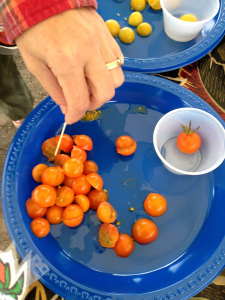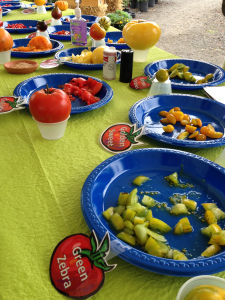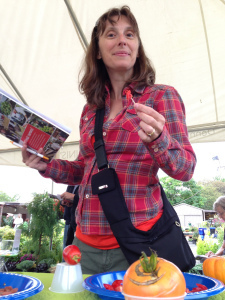Kristy Athens's Blog, page 7
December 1, 2013
Propane 101
When we lived in Portland, our furnace and stove ran on natural gas. They were connected to a network of pipes that brought gas into our house any time we needed it. Out in Enterprise, we’re still running on gas, but this time it’s propane. It’s in a tank in the yard. And we have to monitor it so we don’t run out.
We heated our house in White Salmon with wood, and the stove and hot water were powered by electricity, so propane is a new thing for us. When we started renting this house, part of the deal was buying the existing propane in the tank. It’s a 500-gallon tank, so this was no small bill! But when we leave, the owners will buy whatever is in the tank back from us, so it will all work out.
Propane is actually a by-product of mining natural gas; it has more BTUs than natural gas and, of course, is therefore more expensive because you can use less of it.
I called the propane supplier shortly after we arrived; the man who drove his big tanker up the hill to our house, Archie, was more than happy to take the time to answer my questions. In fact, he was rather pleased that I was asking any.
“Usually, people just want me to fill their tank and get going,” he said.
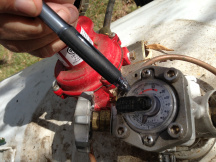
Archie explains how to read the dial
The lid of our tank is green to signify which company services it. Archie showed me the dial that indicates the amount of gas left. He explained that the gas is liquid under pressure; they leave “expansion room” in the tank (about 50 gallons’ worth) to accommodate hot weather. There is also a relief valve, which he said might pop every once in a while during the summer.
Archie carries a notebook in which he tracks all his customers’ usage records. From this, he could estimate that we might use 30 to 40 gallons a year for cooking, but 80 gallons a month from October to April because of the furnace. This year, propane cost $1.79 a gallon, but Archie said the price went up to $2.76 last year. At that price, propane is kind of an expensive way to heat a house!
Some people fill only a couple times a year; some have Archie come by once a month for a “top-off,” so it’s a more manageable and predictable expense.
Siting a tank is important: Near-but-not-too the house, near the road, not somewhere that a visitor will accidentally back into it with their truck.
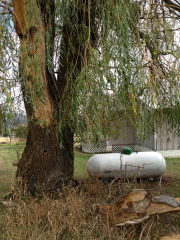
This willow cleaved in a recent storm—luckily it was the far side
I wax in Get Your Pitchfork On! about the joys of heating with wood. If I had my druthers, this house would also have a wood stove. But, it doesn’t, so in the meantime I will enjoy not ever having a cold house because the fire went out!


November 24, 2013
Tomato Tasting
Now that it’s good and cold—in the northern United States anyway—I thought I would warm us up a bit by reporting on a tomato-tasting Mike and I attended in September. The Dennis’ 7 Dees nursery staff took the whole thing fairly seriously—it was a competition, after all, in its ninth year. There was professional signage, lists of descriptions and days-to-maturity, and even a scoring sheet. And there were tomatoes. Dozens of types of tomatoes.
I tend to favor those ugly, bulbous heirlooms—it’s all about the flavor and texture. When I lived in the Columbia River Gorge, I picked Persimmon, Mortgage Lifter and Big Beef as my go-to breeds. I also planted one Early Girl just because they mature sooner, and those little yellow pear-shaped cherry tomatoes. I tried Stupice but they never wowed me; I never settled on a particular type of Roma. Here was my chance to try some of the kinds I’d seen in seed catalogs but never grown.
The selection was impressive. 2013 was a good year for tomatoes in Portland, so they all looked robust. Each breed had a full-grown tomato on display as well as a plate with its vine-mates cut into pieces, and a sign to indicate what it was. The nursery made the scoring sheet for visitors that they could keep, and also tracked favorites so they would be sure to stock them the following spring.
I was interested in the Zebra breeds as I met their creator, Tom Wagner, at an InFARMation event in 2012. Delicious. I loved the Pineapple and Black Russian specimens. But my favorite, I think (after a while the acids render your tastebuds useless), was the Striped German. Dense, sweet, zippy. Tender. I found myself going back to it just to be sure it was actually my favorite.
I’m not sure what tomatoes I can grow here at 4,300 feet. But I have an idea of what I want to plant! In the meantime, I will enjoy the vibrant colors of these photos.
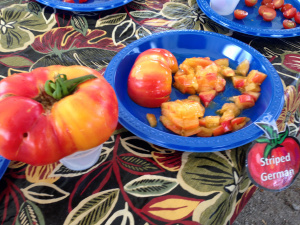
The Winner!


November 17, 2013
Winter Gardening
Most gardeners spend the autumn months putting everything “to bed”—pulling any remaining dead plants; mulching; maybe planting some garlic bulbs for the following spring. Not Niki Jabbour! For her, winter is just another gardening season.
Niki is the author of Year-Round Vegetable Gardener from Storey Press. We exchanged books a couple of months ago, and I’m glad we did! Niki has worked out an impressive system of cold frames, row covers and hoop houses that keeps her in fresh food all year ‘round. The clincher? She lives in Nova Scotia. First-frost-in-October-and-last-frost-in-May Nova Scotia.
 Year-Round Vegetable Gardener is organized by season and then by crop (vegetables and herbs), making it an easy reference. She covers all the usual suspects, and also some cold-hardy greens I’d never heard of, like mibuna, claytonia, and mâche. Well, I’d heard of claytonia, but only as miner’s lettuce, and I’d only seen it wild on our land in Washington.
Year-Round Vegetable Gardener is organized by season and then by crop (vegetables and herbs), making it an easy reference. She covers all the usual suspects, and also some cold-hardy greens I’d never heard of, like mibuna, claytonia, and mâche. Well, I’d heard of claytonia, but only as miner’s lettuce, and I’d only seen it wild on our land in Washington.
Jabbour spent the time to get photos from all seasons to demonstrate what she’s talking about. She also includes the gardens of a few neighbors to present the widest variety of strategies possible. Photographs explain how to build some of the coverings shown.
The book has an engaging layout and a friendly, encouraging tone. Pull-outs and sidebars provide her favorite seed varieties, when to plant in relation to first and last frost, and other hints and tidbits.
Now, the rest of us have no excuse not to grow fresh food all year.


November 10, 2013
Doggone Happy
It’s been a long time coming. When my husband’s and my dog, Phynn, was killed on the highway by our house in White Salmon, we were devastated. We decided to wait a year before replacing her, and then I lost my job and we could no longer afford a dog. When we sold our farm, we lacked a secure home, and then when we rented in Portland the man who owned our house wouldn’t let us have a dog.
The long and short of it is … we haven’t had a dog in seven years. It’s been a long seven years. So, when we found a house to rent in Enterprise that allows pets, we figured we should make up for lost time. Without further ado, I give you Cap’n and Pendleton!
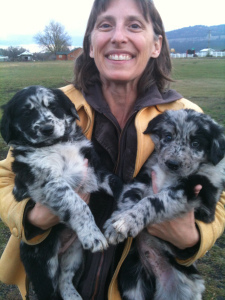
Cap’n on the left; Pendleton on the right. Very happy me in the middle
The link below will take you to a video I uploaded to YouTube:


November 3, 2013
First Snow
Seldom do things work this neatly: Mike mowed on Sunday, and we woke Monday morning to snow flurries!
I find few things as cozy as sitting in a warm house and watching snow fall. The idea of snow in October might fill some of your hearts with dread. But, this year at least, I am totally ready for it. We had a beautiful spring and possibly a record-breaking summer in Portland (No rain in May? No rain in June??). I have been so crazy-busy for the last year (or two years … or five years … I’ve lost count) that I am looking forward to getting snowed in this winter and staying put for a few months.
This Monday-morning squall dropped snow for about an hour, after which it immediately started to melt. It was gone by the afternoon. But I ran out and took some photos once the skies cleared.

Snowy wheat
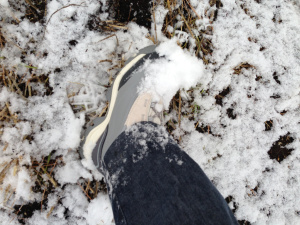
Snowy new snow boot
I love the feeling of coming inside from playing in the snow, when your cheeks are cold but your body glows from the exercise.
I don’t know if it was this storm in particular, or if we’re in a snow belt. After the storm, there was no snow in the trees on the slope above us, nor below us in the valley. This was the opposite of the cold, dry days we’ve been having, when the frost settles in the valley but is already burned off at our house. It’s an interesting mix of physics—cold settles, but we are higher in elevation, facing east.
I predict we will have ample chance to continue this study!
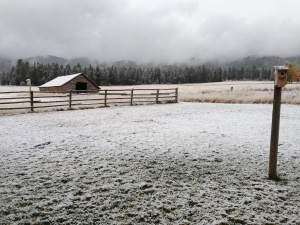
More where this came from …


October 27, 2013
Post Haste
I’ve always been a mail addict. As soon I learned to write, my mom encouraged me to send letters to my cousins and thank-you notes to my grandparents. There was a show on Saturday morning television in the mid-1970s called Big Blue Marble—a magazine-style show that profiled kids from all over the world and offered a pen-pal matchmaking service. I exchanged letters with kids from Iowa, California, Germany, and even Sri Lanka well into high school. When my husband proposed marriage, he incorporated our mailbox in a series of scavenger-hunt clues that led me to him.
When we moved to the Columbia River Gorge, I thought my dreams were finally coming true—I’d always wanted to walk down the driveway to a mailbox on the road. I was disappointed when we ended up having to get a post office box in town. Driving six miles to get my mail was not part of my country fantasy.
Our new house finally fits the bill! The mailbox is not at the end of the driveway but at a collection point not far from the house, where our box and those of our nearest neighbors are lined up.
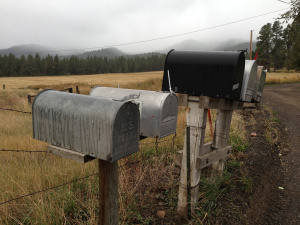 One of the first orders of business upon my arrival was to figure out when the mail is delivered, and by whom, at our new home. We are four miles outside of Enterprise, so I figured it wouldn’t be super early. But then again, maybe the mailperson drove out to the edge of town and then worked his or her way back in? The suspense was killing me.
One of the first orders of business upon my arrival was to figure out when the mail is delivered, and by whom, at our new home. We are four miles outside of Enterprise, so I figured it wouldn’t be super early. But then again, maybe the mailperson drove out to the edge of town and then worked his or her way back in? The suspense was killing me.
There was a bunch of mail waiting for us the day we drove the big moving truck out to Enterprise—hooray! I was happy to know the forwarding thing was happening. The next day, I checked the mail at about 10. Nothing. I went back at lunch. Nope. Then, I got busy with some projects and didn’t check again until after 5.
My desk is at a window that looks out over the road, so the next day I watched for a mail truck. We’re at the end of said road, so anyone up here is either a neighbor or a utility worker. I knew that few mail carriers use those USPS-issued jeeps anymore; they mostly throw a magnetized decal on the side of their own vehicle. Any time a truck came up my road, I watched. I was fooled a couple times by a truck with a county or utility logo.
Finally, I saw my truck, a gray SUV. I ran to the other side of the house in time to confirm through the window—the driver filled the boxes, turned around and started back down the hill. I haven’t been out there yet to meet her, but I will. Because now I know who I’m looking for!


October 20, 2013
Autumn Spawn
Last week, Mike coaxed me away from my desk to drive up to Wallowa Lake. It was a beautiful afternoon and, I had to admit, I haven’t spent much time out of our new house except to travel to Pendleton and Portland. So, off we went, across Alder Slope, through Joseph, and around to the south side of the lake, where it is fed by the Wallowa River.
The reservoir itself was low; the exposed shore revealed thousands of beautiful stones, worn smooth by the waves’ rubbing them together. We pocketed examples of the mountains’ geologic layers: greenstone, granite and basalt.
The state park had posted signs warning not to disturb the water because salmon were spawning. We crept upriver to investigate. Sure enough, 7-inch fish known as “kokanee” appeared in every side stream. They’re the antithesis of the steelhead I mentioned in my springtime fishing post: rather than being ocean-going trout, kokanee are land-locked salmon.
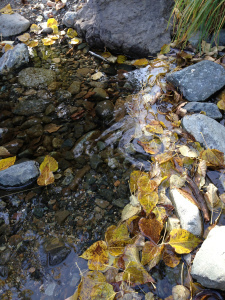
Living fish are difficult to photograph! I swear they’re in there
However, they still have the instinct to swim upriver and spawn in the gravel beds of fast-moving water. The kokanees’ red backs stuck out from the browns and oranges of the rocks and dead foliage that had sunk to the bottom. As we walked upriver, we saw some kokanee preparing to ford a new set of rapids, some fighting each other, some shaking up the gravel with their tails. They were everywhere.
And then we noticed that some of them were another kind of fish, about the same size. Brown with a rainbow sheen on the side, and spots. They looked an awful lot like trout … but why would trout be spawning in the same place as salmon?
Later that day, we took our question to our friend and resident Fishing Guru, Jon Rombach. “What were they doing there?” we asked.
“Feasting, probably,” he said. Turns out, trout follow salmon upstream to avail themselves of an easy, eggy meal.
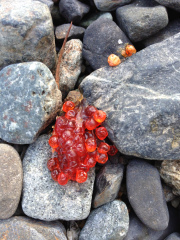
Salmon spawn = trout treat!
In addition to the hundreds of live fish, there were also plenty of ones who had already fulfilled their mission, or not, and relinquished their grip on this earthly plane. I’ve seen spawning salmon at Multnomah Falls, Northwestern Lake and Bull Run; it was fun to see this miniature version fulfilling its same, genetically coded destiny.
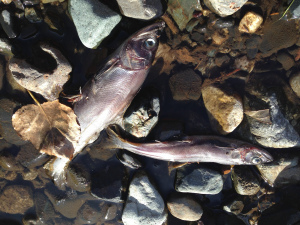
Easier to capture these guys …


October 13, 2013
Cooking with a Good Altitude
Mike and I are just getting settled, unpacked and back to the business of living life. The house we’re renting has a well-appointed kitchen, so we (read: Mike) were looking forward to digging in. I even started planning my first pumpkin pie in years!
But, something was wrong. Things were boiling over constantly, even on low heat. We thought the stove was just extra-powerful, or maybe propane had more heat than natural gas or electricity. But then oatmeal took 45 minutes to cook. What was going on?
We mentioned it to one of Mike’s colleagues, Jon, who is also new to the area.
“I know,” he commiserated. “I tried to make bread the other day, and it was a disaster. I have to figure out how to adjust for this altitude.”
Altitude! I remember reading about this on cake-mix boxes and canning instructions. Our house is at approximately 4,300 feet—quite a jump from Portland, which is a mere 50 feet above sea level. Even our house in the Columbia River Gorge had no issues.

Breakfast oatmeal became brunch oatmeal
I did some research and learned that the main difference is air pressure. Same as a pressure cooker makes things cook faster, elevation, with less air pressure, makes things cook more slowly. It also lowers the boiling point of water, meaning you need to add more because it starts evaporating before the food is finished.
And that’s just cooking—baking is a whole ‘nother story. Jon’s bread quickly went awry. “It rose like crazy,” he said, “and then collapsed. The loaves were like pucks.”
Turns out that you have to add more dry ingredients, except leavening agents like yeast. Less of that. This website is pretty thorough about guidelines.
I’m a bad enough cook as it is; I hope that I can survive adjusting for altitude!


October 6, 2013
First Impressions
Mike and I moved to this new house in Wallowa County a little over a week ago. I’m thrilled to share the following report!
If you’ve never looked at Wallowa County on a map, I recommend it. For even more fun, learn about its geology. After 18 years of hiking around on basalt, it’s fun to see granite again.
The house is “up Alder Slope,” meaning the west side of the Wallowa River Valley. It’s closer to Enterprise than to Joseph. We gain a couple hundred feet of elevation on a road that heads straight up from town—no one will ever be able to sneak up on us! From our perch we can see both towns, the Wallowas, of course, and even the peaks of the Seven Devils in Idaho.

The moving truck, Mike, and THE VIEW
I’ve seen all kinds of wildlife. The first time we pulled in the driveway, a flock of quail scattered. We share this land with them and also hawks and eagles, rufous-sided towhees, flickers, mourning doves, magpies, Steller’s jays, Le Conte’s sparrows—and those are just the ones that have made their presence known. I’m sure the characters will change some with the seasons. Mike did not see a single crow while he was here this summer, but a huge murder of them came through the other day, bound for their winter habitat. The starlings seem to be more migratory as well—there were at least a hundred in the field a few days ago, and none before or since.
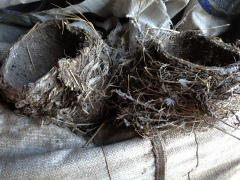
Abandoned nests in the barn
Does and their near-grown fawns pick through the wheat stubble in the mornings and evenings. A flock of pigeons inhabits the decrepit old barn, which is, allegedly, the home of a bull elk as well. One morning, a coyote trotted across the field above the barn. I went out to watch it; it stopped a couple of times to acknowledge my presence, and then kept going.
One thing about living on the east-facing slope of a mountain range: You don’t know what weather is coming! I drove into town on a sunny afternoon recently, only to turn around when I got there and see an enormous storm cresting the western horizon. We won’t get much in the way of sunsets, but the sunrises … oh, my. In the city, you can’t get me out of the house at 8 in the morning, even if it’s on fire. In the country, I’ve already started waking up with the sun (or at least around 7 …).
We live in the middle of an 80-acre wheat field. Yesterday, I walked up to the old barn to check it out (lots of pigeon poo), and then around the edge of the field. The man who leases the field had missed a thin swath of wheat when he harvested, so I picked a little sheaf and hung it in the house. A symbol, I’m hoping, of our prosperity here.


September 29, 2013
Alphorn Harvest
It’s autumn again! Where did the year go? Last fall, I covered husband Mike’s and my thorough celebration of harvest time in Portland. This year, we live in the shadow of the Wallowa Mountains, known as the “Alps of North America.” So it makes sense that the celebration here is Alpenfest—a celebration of Swiss-German culture.
The weekend’s events kicked off on Friday evening at Terminal Gravity pub, in Enterprise. A band in tracht played polka music as the proprietor tapped a keg of ale brewed especially for the occasion. The featured meal was a bratwurst with sauerkraut, all made locally.
Look closely at these “accordions”—they’re actually electronic!
The highlight for me was a man named Bruce Coutant. As a young man, he had a career as a professional French horn player in Los Angeles. After a while, he moved to the Wallowa County town of Lostine and began a new career as a carpenter. A few years ago, he put the two together to become one of North America’s few alphorn builders.
An alphorn is approximately twice the height of its player
I’ve seen photos of alphorns and have always assumed they produce one long tone, like a conch shell. I couldn’t be more wrong. Bruce squared his shoulders, took a deep breath and launched into a sorrowful, short tune. Then another, a little perkier. Then another, jaunty and sweet. The range of notes he could hit was astonishing. The instrument has no keys, just a mouthpiece and an 11-foot sloping horn with a bell at the end. He created notes as one does on a bugle, simply with embouchure.
Between songs, Bruce explained the history of the instrument. Each family had an alphorn, and each son got one once he was old enough to escort the cows as they roamed up and down the valleys.
“They were the cell phones of the day!” said Bruce. A shepherd would play his signature ditty as a way of telling his family he was okay, and the family would respond in kind. A little research indicates that they were also used to welcome people to church, call cows in for milking, and communicate between villages.
I sipped my Alpenfest ale and hoped that the alphorn’s rich tones would carry across the Wallowa River valley, across the United States, all the way to Switzerland.




